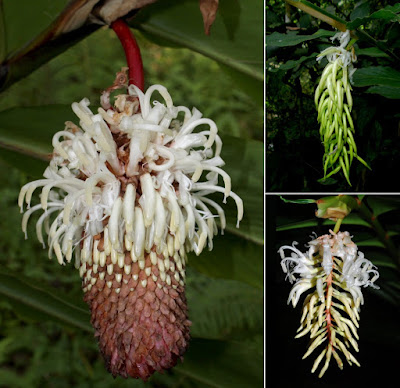 |
Sinopyrophorus schimmeli Bi & Li
in Bi, He, Chen, Kundrata & Li, 2019.
|
Abstract
The new subfamily Sinopyrophorinae within Elateridae is proposed to accommodate a bioluminescent species, Sinopyrophorus schimmeli Bi & Li, gen. et sp. nov., recently discovered in Yunnan, China. This lineage is morphologically distinguished from other click-beetle subfamilies by the strongly protruding frontoclypeal region, which is longitudinally carinate medially, the pretarsal claws without basal setae, the hind wing venation with a well-defined wedge cell, the abdomen with seven (male) or six (female) ventrites, the large luminous organ on the abdominal sternite II, and the male genitalia with median lobe much shorter than parameres, and parameres arcuate, with the inner margin near its apical third dentate. Molecular phylogeny based on the combined 14 mitochondrial and two nuclear genes supports the placement of this taxon far from other luminescent click-beetle groups, which provides additional evidence for the multiple origin of bioluminescence in Elateridae. Illustrations of habitus and main diagnostic features of S. schimmeli Bi & Li, gen. et sp. nov. are provided, as well as the brief description of its luminescent behavior.
Keywords: China, mitochondrial genome, molecular phylogeny, new genus, new species, taxonomy
 |
Figures 2–3. Habitus of Sinopyrophorus schimmeli Bi & Li, gen. et sp. nov.
paratypes 2 male 3 female. a, dorsal view; b, ventral view; c, lateral view. |
 |
Figures 4–16. Sinopyrophorus schimmeli Bi & Li, gen. et sp. nov.
Male 4 head (anterior view) 5 labrum and mandibles (dorsal view) 6 labium 7 maxilla 8 prothorax 9 scutellum (dorsal view) 10 mesoventrite (ventral view) 11 mesoventrite (lateral view) 12 tarsomeres II–IV (lateral view) 13 tarsal claw (lateral view) 14 hind wing 15 ventrites IV–VII 16 abdominal luminescent organ (pale area above ventrite I). a, dorsal view; b, ventral view; c, lateral view. Scale bars: 0.25 mm (4–11); 0.1 mm (12, 13); 1 mm (14); not to scale (15, 16). |
Taxonomy
Sinopyrophorus Bi & Li, gen. nov.
= Sinopyrophorus He et al., 2019: 565
[nomen nudum; published without description, unavailable name according to the ICZN (1999, Art. 13)].
Type species: Sinopyrophorus schimmeli Bi & Li, sp. nov., here designated.
Diagnosis: Head with frontoclypeal region (Fig. 4) strongly protruding, longitudinally strongly carinate medially; antennomeres II and III short, subequal in length; clicking mechanism (i.e., prosternal process fitting into mesoventral cavity) fully developed; prosternal process straight in lateral view, pretarsal claw (Fig. 13) lacking setae at base; hind wing (Fig. 14) with well-defined wedge cell; abdomen with seven (male) or six (female) ventrites; large transverse luminous organ present on abdominal sternite II (Fig. 16); aedeagus (Fig. 20) with parameres arcuate and median lobe much shorter than parameres.
Etymology: The generic name is derived from the Latin prefix sino-, which means Chinese, and Pyrophorus, a bioluminescent click-beetle genus from Central and South America. Gender masculine.
Distribution: China: Western Yunnan.
Sinopyrophorus schimmeli Bi & Li, sp. nov.
Etymology: This species is named in honor of late Mr. Rainer Schimmel, a specialist in Elateridae, who kindly provided valuable comments at the beginning of this study.
Sinopyrophorinae Bi & Li, subfam. nov.
Type genus: Sinopyrophorus Bi & Li, gen. nov., here designated.
Diagnosis: The molecular phylogenetic analysis (Fig. 1) and morphology (Figs 2–23) justify the establishment of a new monogeneric subfamily Sinopyrophorinae Bi & Li, subfam. nov. within Elateridae. Sinopyrophorinae are easily recognizable by the strongly protruding frontoclypeal region (Fig. 4), which is medially distinctly longitudinally carinate, antennomeres II and III subequal in length and together less than half as long as antennomeres IV–XI, pronotal hind angles (Fig. 8) acute, produced posterolaterally, prosternal process (Fig. 8c) straight in lateral view, tarsomeres III and IV (Fig. 12) with ventral lobes, abdomen with seven (male) or six (female) ventrites, with a luminous organ (Fig. 16) on sternite II, and aedeagus (Fig. 20) with a median lobe shorter than phallobase, and arcuate parameres.
Wen-Xuan Bi, Jin-Wu He, Chang-Chin Chen, Robin Kundrata and Xue-Yan Li. 2019. Sinopyrophorinae, A New Subfamily of Elateridae (Coleoptera, Elateroidea) with the First Record of A Luminous Click Beetle in Asia and Evidence for Multiple Origins of Bioluminescence in Elateridae.
ZooKeys. 864: 79-97. DOI:
10.3897/zookeys.864.26689
The first bioluminescent click beetle discovered in Asia represents a new subfamily
bit.ly/30PbABV via @Pensoft @EurekAlert













































